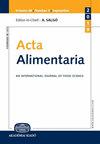Influence of growing season, nitrogen fertilisation and wheat variety on Fusarium infection and mycotoxin production in wheat kernel
IF 1
4区 农林科学
Q4 FOOD SCIENCE & TECHNOLOGY
引用次数: 2
Abstract
Fusarium spp. are phytopathogens causing fusarium head blight in wheat. They produce mycotoxins, mainly fumonisins, deoxynivalenol, and zearalenone. The study was conducted during two growing seasons (2020 and 2021) at the experimental field and laboratories of the Hungarian University of Agriculture and Life Sciences (MATE). The aim of the study was to determine the influence of growing season, nitrogen fertilisation, and wheat variety on Fusarium infection and mycotoxin production in wheat kernel. Zearalenone was not detected during the two growing seasons and deoxynivalenol was only detected in 2020. The results indicate that nitrogen fertilisation and wheat variety did not have statistically significant influence on Fusarium infection and mycotoxin production. The growing season had statistically significant influence on Fusarium infection and fumonisins production due to higher rainfall in 2021 compared to 2020 during the flowering period when the wheat spike is the most vulnerable to Fusarium infection.生长季节、氮肥和小麦品种对小麦籽粒镰刀菌感染和真菌毒素产生的影响
镰刀菌属是引起小麦枯萎病的植物病原体。它们产生真菌毒素,主要是伏马菌素、脱氧雪腐镰刀菌烯醇和玉米赤霉烯酮。这项研究在两个生长季节(2020年和2021年)在匈牙利农业与生命科学大学(MATE)的试验场和实验室进行。本研究的目的是确定生长季节、氮肥和小麦品种对小麦籽粒中镰刀菌感染和真菌毒素产生的影响。在两个生长季节未检测到玉米赤霉烯酮,脱氧雪腐镰刀菌烯醇仅在2020年检测到。结果表明,氮肥和小麦品种对镰刀菌感染和真菌毒素产生的影响不显著。生长季节对镰刀菌感染和伏马菌素生产产生了统计上的显著影响,因为在小麦穗最容易感染镰刀菌的开花期,2021年的降雨量比2020年更高。
本文章由计算机程序翻译,如有差异,请以英文原文为准。
求助全文
约1分钟内获得全文
求助全文
来源期刊

Acta Alimentaria
农林科学-食品科技
CiteScore
1.80
自引率
0.00%
发文量
47
审稿时长
18-36 weeks
期刊介绍:
Acta Alimentaria publishes original papers and reviews on food science (physics, physical chemistry, chemistry, analysis, biology, microbiology, enzymology, engineering, instrumentation, automation and economics of foods, food production and food technology, food quality, post-harvest treatments, food safety and nutrition).
 求助内容:
求助内容: 应助结果提醒方式:
应助结果提醒方式:


